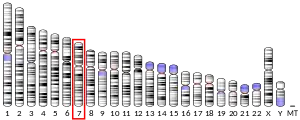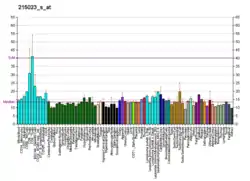PEX1
Peroxisome biogenesis factor 1, also known as PEX1, is a protein which in humans is encoded by the PEX1 gene.[5]
This gene encodes a member of the AAA protein family, a large group of ATPases associated with diverse cellular activities. This protein is cytoplasmic but is often anchored to a peroxisomal membrane where it forms a heteromeric complex and plays a role in the import of proteins into peroxisomes and peroxisome biogenesis. Mutations in this gene have been associated with complementation group 1 peroxisomal disorders such as neonatal adrenoleukodystrophy, infantile Refsum disease, and Zellweger syndrome.[5]
References
- GRCh38: Ensembl release 89: ENSG00000127980 - Ensembl, May 2017
- GRCm38: Ensembl release 89: ENSMUSG00000005907 - Ensembl, May 2017
- "Human PubMed Reference:". National Center for Biotechnology Information, U.S. National Library of Medicine.
- "Mouse PubMed Reference:". National Center for Biotechnology Information, U.S. National Library of Medicine.
- "Entrez Gene: PEX1 peroxisome biogenesis factor 1".
- Tamura, S; Shimozawa N; Suzuki Y; Tsukamoto T; Osumi T; Fujiki Y (Apr 1998). "A cytoplasmic AAA family peroxin, Pex1p, interacts with Pex6p". Biochem. Biophys. Res. Commun. UNITED STATES. 245 (3): 883–6. doi:10.1006/bbrc.1998.8522. ISSN 0006-291X. PMID 9588209.
- Geisbrecht, B V; Collins C S; Reuber B E; Gould S J (Jul 1998). "Disruption of a PEX1-PEX6 interaction is the most common cause of the neurologic disorders Zellweger syndrome, neonatal adrenoleukodystrophy, and infantile Refsum disease". Proc. Natl. Acad. Sci. U.S.A. UNITED STATES. 95 (15): 8630–5. Bibcode:1998PNAS...95.8630G. doi:10.1073/pnas.95.15.8630. ISSN 0027-8424. PMC 21127. PMID 9671729.
- Matsumoto, Naomi; Tamura Shigehiko; Fujiki Yukio (May 2003). "The pathogenic peroxin Pex26p recruits the Pex1p-Pex6p AAA ATPase complexes to peroxisomes". Nat. Cell Biol. England. 5 (5): 454–60. doi:10.1038/ncb982. ISSN 1465-7392. PMID 12717447. S2CID 2426040.
Further reading
- Wanders RJ (2004). "Metabolic and molecular basis of peroxisomal disorders: a review". Am. J. Med. Genet. A. 126 (4): 355–75. doi:10.1002/ajmg.a.20661. PMID 15098234. S2CID 24025032.
- Crane DI, Maxwell MA, Paton BC (2006). "PEX1 mutations in the Zellweger spectrum of the peroxisome biogenesis disorders". Hum. Mutat. 26 (3): 167–75. doi:10.1002/humu.20211. PMID 16086329. S2CID 20330106.
- Naritomi K, Izumikawa Y, Ohshiro S, et al. (1990). "Gene assignment of Zellweger syndrome to 7q11.23: report of the second case associated with a pericentric inversion of chromosome 7". Hum. Genet. 84 (1): 79–80. doi:10.1007/BF00210677. PMID 2606480. S2CID 44388911.
- Reuber BE, Germain-Lee E, Collins CS, et al. (1997). "Mutations in PEX1 are the most common cause of peroxisome biogenesis disorders". Nat. Genet. 17 (4): 445–8. doi:10.1038/ng1297-445. PMID 9398847. S2CID 34034756.
- Portsteffen H, Beyer A, Becker E, et al. (1997). "Human PEX1 is mutated in complementation group 1 of the peroxisome biogenesis disorders". Nat. Genet. 17 (4): 449–52. doi:10.1038/ng1297-449. PMID 9398848. S2CID 2487398.
- Faber KN, Heyman JA, Subramani S (1998). "Two AAA family peroxins, PpPex1p and PpPex6p, interact with each other in an ATP-dependent manner and are associated with different subcellular membranous structures distinct from peroxisomes". Mol. Cell. Biol. 18 (2): 936–43. doi:10.1128/mcb.18.2.936. PMC 108805. PMID 9447990.
- Tamura S, Okumoto K, Toyama R, et al. (1998). "Human PEX1 cloned by functional complementation on a CHO cell mutant is responsible for peroxisome-deficient Zellweger syndrome of complementation group I." Proc. Natl. Acad. Sci. U.S.A. 95 (8): 4350–5. Bibcode:1998PNAS...95.4350T. doi:10.1073/pnas.95.8.4350. PMC 22492. PMID 9539740.
- Tamura S, Shimozawa N, Suzuki Y, et al. (1998). "A cytoplasmic AAA family peroxin, Pex1p, interacts with Pex6p". Biochem. Biophys. Res. Commun. 245 (3): 883–6. doi:10.1006/bbrc.1998.8522. PMID 9588209.
- Geisbrecht BV, Collins CS, Reuber BE, Gould SJ (1998). "Disruption of a PEX1-PEX6 interaction is the most common cause of the neurologic disorders Zellweger syndrome, neonatal adrenoleukodystrophy, and infantile Refsum disease". Proc. Natl. Acad. Sci. U.S.A. 95 (15): 8630–5. Bibcode:1998PNAS...95.8630G. doi:10.1073/pnas.95.15.8630. PMC 21127. PMID 9671729.
- Collins CS, Gould SJ (1999). "Identification of a common PEX1 mutation in Zellweger syndrome". Hum. Mutat. 14 (1): 45–53. doi:10.1002/(SICI)1098-1004(1999)14:1<45::AID-HUMU6>3.0.CO;2-J. PMID 10447258.
- Tamura S, Matsumoto N, Imamura A, et al. (2001). "Phenotype-genotype relationships in peroxisome biogenesis disorders of PEX1-defective complementation group 1 are defined by Pex1p-Pex6p interaction". Biochem. J. 357 (Pt 2): 417–26. doi:10.1042/0264-6021:3570417. PMC 1221968. PMID 11439091.
- Preuss N, Brosius U, Biermanns M, et al. (2002). "PEX1 mutations in complementation group 1 of Zellweger spectrum patients correlate with severity of disease". Pediatr. Res. 51 (6): 706–14. doi:10.1203/00006450-200206000-00008. PMID 12032265.
- Maxwell MA, Allen T, Solly PB, et al. (2003). "Novel PEX1 mutations and genotype-phenotype correlations in Australasian peroxisome biogenesis disorder patients". Hum. Mutat. 20 (5): 342–51. doi:10.1002/humu.10128. PMID 12402331. S2CID 26081019.
- Scherer SW, Cheung J, MacDonald JR, et al. (2003). "Human chromosome 7: DNA sequence and biology". Science. 300 (5620): 767–72. Bibcode:2003Sci...300..767S. doi:10.1126/science.1083423. PMC 2882961. PMID 12690205.
- Matsumoto N, Tamura S, Fujiki Y (2003). "The pathogenic peroxin Pex26p recruits the Pex1p-Pex6p AAA ATPase complexes to peroxisomes". Nat. Cell Biol. 5 (5): 454–60. doi:10.1038/ncb982. PMID 12717447. S2CID 2426040.
- Dodt G, Walter C (2004). Study of mutant proteins with folding defects in cultured patient cells. Methods Mol. Biol. 232. pp. 165–73. doi:10.1385/1-59259-394-1:165. ISBN 1-59259-394-1. PMID 12840548.
- Hillier LW, Fulton RS, Fulton LA, et al. (2003). "The DNA sequence of human chromosome 7". Nature. 424 (6945): 157–64. Bibcode:2003Natur.424..157H. doi:10.1038/nature01782. PMID 12853948.
External links
- GeneReviews/NCBI/NIH/UW entry on Peroxisome Biogenesis Disorders, Zellweger Syndrome Spectrum
- OMIM entries on Peroxisome Biogenesis Disorders, Zellweger Syndrome Spectrum
This article is issued from Wikipedia. The text is licensed under Creative Commons - Attribution - Sharealike. Additional terms may apply for the media files.






